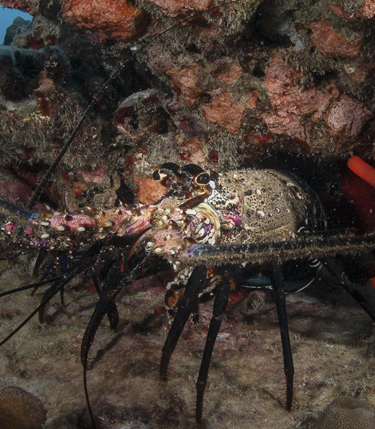Published in the Ocean Watch column, Honolulu Star-Advertiser © Susan Scott
March 3, 2014
During one of those muggy Kona weather days, I went snorkeling off Lanikai Beach in water that was calm, clear and refreshing. I swam over the dense coral heads off the center of the beach, looking for fish and invertebrates to brighten my day.
After about 30 minutes I had seen only flashes of fish diving for cover and little else. Discouraged over the lack of marine life, I turned toward the beach to swim home.
 Hawaii’s lobsters, including the spiny lobster,
Hawaii’s lobsters, including the spiny lobster,
are easy to capture, but they’re scarce because of overfishing.
Courtesy Russell Gilbert
It was a good place to turn. Two telltale signs of a marine animal that I rarely see while snorkeling moved and caught my eye. I dived down and looked into the big, googly eyes of a young spiny lobster.
Lobsters are like giant shrimp with two main differences: Lobsters have thicker, harder shells, and all live on the ocean floor.
Lobsters come in two main groups: one with big pincers on the end of their front legs, called “true lobsters,” and one without.
The most familiar true lobster is the American lobster, the big-clawed species familiar to diners. Hawaii doesn’t host the cold-water American lobster, but we have seven species of true lobsters in miniature, called reef lobsters.
All are only 4 to 5 inches long and, although fairly common, are not often seen by daytime snorkelers.
Lobsters of all species hunker down during the day, and venture out at night in search of just about any small creature they can catch. Occasionally lobsters add a bit of seaweed salad to their diet.
The lobsters without weapons up front are slipper and spiny lobsters, both found in Hawaii. Slipper lobsters have unusual front antennae that look like two flat paddles.
This is Hawaii’s most common lobster but blends so well against rocky sea floors, it’s often hard to see.
Spiny lobsters are easier to find. What they lack in front pincers they make up for in a pair of thickset antennae longer than the creature’s entire body.
It’s these antennae poking out of ledges that expose the lobsters’ daytime resting places.
Hawaii’s lobsters are easy to catch and have been so overfished they’re now scarce.
To enable these animals to recover, state law prohibits spearing, taking any females with eggs and hunting lobsters from May through August.
Even so, my first thought upon seeing that lovely little undersize lobster, was: Tuck in those antennae! Hide!
Swimming over that nearly empty coral reef drove home a fact that Oahu’s snorkelers, divers and anglers already know: Our island needs more marine sanctuaries. Only then will life return to Oahu’s near-shore reefs.